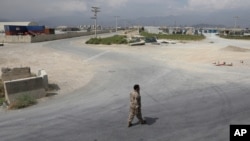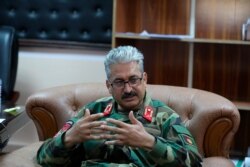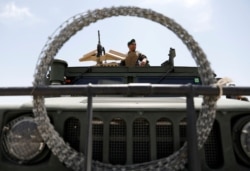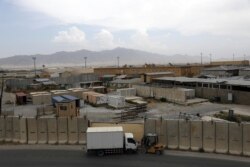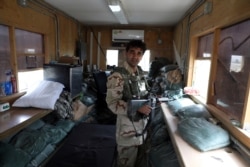The U.S. left Afghanistan's Bagram Airfield after nearly 20 years by shutting off the electricity and leaving in the night, Afghan military officials said, without notifying the base's new Afghan commander, who discovered the Americans' departure more than two hours after they left.
Afghanistan's army showed off the sprawling air base Monday, providing a glimpse of what had been the epicenter of America's war to unseat the Taliban and hunt down the al-Qaida perpetrators of the 9/11 attacks on America.
The U.S. announced Friday it had vacated its biggest airfield in the country in advance of a final withdrawal the Pentagon says will be completed by the end of August.
"We (heard) some rumor that the Americans had left Bagram ... and finally by seven o'clock in the morning, we understood that it was confirmed that they had already left Bagram," said Gen. Mir Asadullah Kohistani, Bagram's new commander.
U.S. military spokesman Col. Sonny Leggett did not address the specific complaints of many Afghan soldiers who inherited the abandoned airfield. He said in the statement that the U.S. coordinated its departures with Afghanistan's leaders and referred to a statement last week.
That statement said the handover had been in the process soon after President Joe Biden's mid-April announcement that America was withdrawing the last of its forces.
Before the Afghan army could take control of the airfield about an hour's drive from the Afghan capital of Kabul, it was invaded by a small army of looters, who ransacked barrack after barrack and rummaged through giant storage tents before being evicted, according to Afghan military officials.
"At first we thought maybe they were Taliban," said Abdul Raouf, a soldier of 10 years.
Kohistani insisted the Afghan National Security and Defense Force could hold on to the heavily fortified base despite a string of Taliban wins on the battlefield. The airfield also includes a prison with about 5,000 prisoners, many of them allegedly Taliban.
The Taliban's latest surge comes as the last U.S. and NATO forces pull out of the country. As of last week, most NATO soldiers had quietly left. The last U.S. soldiers are likely to remain until an agreement to protect the Kabul Hamid Karzai International Airport, in which Turkey is expected to take the lead, is completed.
Taliban advances
Meanwhile, in northern Afghanistan, district after district has fallen to the Taliban. In the last two days hundreds of Afghan soldiers fled across the border into Tajikistan rather than fight the insurgents.
"In battle it is sometimes one step forward and some steps back," Kohistani said.
Kohistani said the Afghan military is changing its strategy to focus on the strategic districts. He insisted they would retake them in the coming days without saying how that would be accomplished.
On Monday Kohistani opened Bagram, a massive facility that had been exclusively used by the U.S. and NATO. It is the size of a small city, with roadways weaving through barracks and past hangarlike buildings. There are two runways and more than 100 parking spots for fighter jets known as revetments because of the blast walls that protect each aircraft. One of the two runways is 3,660 meters (12,000 feet) long and was built in 2006. There's a passenger lounge, a 50-bed hospital and giant hangar-size tents filled with supplies such as furniture.
What the US left behind
Kohistani said the U.S. left behind 3.5 million items, all itemized by the departing U.S. military. They include tens of thousands of bottles of water, energy drinks and military ready made meals, known as MRE's.
"When you say 3.5 million items, it is every small items, like every phone, every door knob, every window in every barracks, every door in every barracks," he said.
The big ticket items left behind include thousands of civilian vehicles, many of them without keys to start them, and hundreds of armored vehicles. Kohistani said the U.S. also left behind small weapons and the ammunition for them, but the departing troops took heavy weapons with them. Ammunition for weapons not being left behind for the Afghan military was blown up before they left.
Afghan soldiers who wandered Monday throughout the base that had once seen as many as 100,000 U.S. troops were deeply critical of how the U.S. left Bagram, leaving in the night without telling the Afghan soldiers tasked with patrolling the perimeter.
"In one night, they lost all the goodwill of 20 years by leaving the way they did, in the night, without telling the Afghan soldiers who were outside patrolling the area," said Afghan soldier Naematullah, who asked that only his one name be used.
Within 20 minutes of the U.S. departure Friday, the electricity was shut down and the base was plunged into darkness, said Raouf, the soldier, who has also served in Taliban strongholds of Helmand and Kandahar provinces.
The sudden darkness was like a signal to looters, he said. They entered from the north smashing through the first barrier, ransacking buildings, loading anything that was not nailed down into trucks.
On Monday, three days after the U.S. departure, Afghan soldiers were still collecting piles of garbage that included empty water bottles, cans and empty energy drinks left behind by the looters.
Kohistani meanwhile said the nearly 20 years of U.S. and NATO involvement in Afghanistan was appreciated but now it was time for Afghans to step up.
"We have to solve our problem. We have to secure our country and once again build our country with our own hands," he said.




